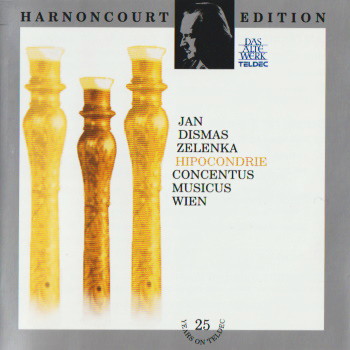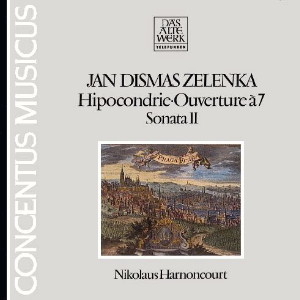 |
1 CD -
Teldec 8.42415 XH (c) 1989
|
 |
| 1 LP -
Telefunken 6.42415 AW (p) 1980 |
|
| NIKOLAUS HARNONCOURT - 25 Years
on TELDEC |
|
|
|
|
|
|
|
| Jan Dismas
Zelenka (1679-1745) |
Hipocondrie, 1723
|
|
|
|
|
|
|
|
|
|
Hipocondrie
à 7 concertanti A-dur für 2
Violinen, 2 Oboen, Viola, Fagott und
B.c. |
|
8' 53" |
A1 |
|
-
(Grave) · Allegro · Lentement ·
Adagio |
|
|
|
|
Sonate
Nr. 2 g-moll für 2 Oboen,
Fagott und B.c. |
|
17' 48" |
|
|
-
Andante |
2' 56" |
|
A2 |
|
-
Allegro |
6' 31" |
|
A3 |
|
-
Andante |
3' 06" |
|
A4 |
|
- Allegro
assai |
5' 15" |
|
A5 |
|
Ouverture
à 7 concertanti F-dur für 2
Violinen, 2 Oboen, Viola, Fagott und
B.c. |
|
20' 01" |
|
|
- Grave ·
Allegro · Grave |
7' 18" |
|
B1 |
|
- Aria |
4' 31" |
|
B2 |
|
- Menuett I
- II |
2' 12" |
|
B3 |
|
-
(Siciliano) |
4' 19" |
|
B4 |
|
- Folie |
1' 41" |
|
B5 |
|
|
|
|
|
| CONCENTUS MUSICUS
WIEN (mit Originainstrumenten) |
|
| - Milan Turković, Fagott |
|
| - Alice Harnoncourt,
Walter Pfeiffer, Peter
Schoberwalter, Anita Mitterer,
Wilhelm Mergl, Violinen |
|
| - Kurt Theiner,
Josef de Sordi, Violen |
|
| - Nikolaus
Harnoncourt, Violoncello |
|
| - Eduard Hruza, Violone |
|
| - Jürg Schaeftlein,
Paul Hailperin, Oboen |
|
| - Milan Turković, Fagott |
|
| - Herbert Tachezi, Cembalo |
|
| Nikolaus
HARNONCOURT, Leitung |
|
|
|
|
|
Luogo
e data di registrazione |
|
Casino
Zögernitz, Vienna (Austria) -
marzo 1977, marzo 1978 e maggio
1979 |
|
|
Registrazione:
live / studio |
|
studio |
|
|
Producer
|
|
- |
|
|
Edizione CD |
|
TELDEC
- 8.42415 XH (244 692-2) - (1 CD -
durata 47' 05") - (c) 1989 - ADD |
|
|
Originale LP
|
|
TELEFUNKEN
- 6.42415 AW - (1 LP - durata 47'
05") - (p) 1980 - Analogico |
|
|
Note |
|
-
|
|
|
|
|
The
name Jan Dismas Zelenka
conveys little to anyone
other than historians, or
rather to a few experts on
Bohemian music during the
baroque period. Not even a
picture of him exists.
Although his 300th
anniversary on 16th October,
1979 gave rise to a slightly
greater knowledge of his
name and some of his
instrumental works, he has
remained unknown, indeed an
anachronism, for all that
his spiritual affinity with
Bach repeatedly been
praised.
Jan Dismas Zelenka came from
Bohemia, from Lounoviĕe
near Blanik, southeast of
Prague. According to the
researches of Milan Pošto1kas
his received
his musical teaching first from his
father and later at the Jesuits’
College in Prague. This may
well be where his religious
outlook was formed, and it
is also possible that it was
here that he wrote
his first religious
compositions, probably
including a cantata
for the Collegium
Clementinuin. From 1710
onwards widcr opportunities
presented themselves to Zelenka
in Dresden,
wherr he
joined the Court orchestra,
originally merely as a
double bass player; in 1715
or 1716 he was considered
worthy of being allowed to
continue his studics in
Vienna with Johann Josef
Fux. The story is that his
teacher soon prevailed upon
the Elector of Saxony to
allow him further study, and
in 1716 Zelenka is said to
have undertaken an extended
study tour to Venice, where
he may have met Antonio
Lotti. Whether in the end he
became a pupil of Alessandro
Scarlatti and Francesco Feo
in Napels is not established.
After completing his
studies, Zelenka returned to
Dresden via Vienna. There
he, who had “graduated” in
the strict style,
had to contend with
Neapolitan opera because the
representative of that art
form, Johann Adolf Hasse,
dominated the musical scene
at Dresden. In
comparison with his status,
Zelenlk’s
own position as
Vice-Kapellmeister of Church
Music, wich he had assumed
on his return in 1721, was
of only secondary interest.
True, he received the
prestigious commission to
write the (Jesuit) opera
"Sub olea pacis” for the
coron ation celebrations in
Prague in 1723, but his
music did not appeal widely,
not least, no doubt, because
of the influence of Fux
on his style. lncidentally,
Zelenka was appointed
Director of Church Music in
1729, and Court Church
Composer in 1735. This
explains his large literary bequest
of movements for Masses,
liturgical vocal music,
oratorios, cantatas, motets
etc., which has still not
been fully explored.
Although Zelenka’s own
career suffered on account
of Hasse’s meteoric rise as
an opera composer, yet he
was sufficiently recept ive
to new artistic trends to
employ the Neapoiitan style
in his works, for example in
his oratorio ”Gesù al
Calvario”. He managed to
come to terms with the
Vivaldi cult as encourag ed
in Dresden by the composer
Johann Georg Pisendel, and
also with the influence of
the style
galant as typified by the works
of his colleague Johann
David Heinichen.
Zelenka’s works, which are
generally guided by
tradition, reflect these
varied influences; even so,
his idiom is quite different
from that of his
contemporaries. While their
orchestral compositions were
predominantly suites based
on well-tried forms, Zelenka
wrote, in addition to
concertos and symphonies
(overtures), so-called
capricci and finally a
concertante work in three
sections for seven parts, to
which he gave the mysterious
name of "Hipocondrie",
Although with its slow
introduction, fugato middle
section and slow ending,
this composition is akin to
the French overture, it is
only in the central section
that Zelenka allows all
instruments their share in
the strict but Well
distributed imitatory
part-writing, without losing
track of the harmonies amid
the welter of modulations. Incidentally,
the description "a 7
concertanti” does not refer
to passages with special
emphasis on the soloists,
but to the totality of the
obbligato parts, in which
Zelenka, in the manner of
the Concerto grosso, makes a
distinction between the
small solo group of the
concertino and the whole
ensemble, which is used to
achieve dense harmonic (i.e.
modulating) effects in the
slow final section. The name
”Hipocondrie” continues to
elude explanation. Is it
possible that the composer
had in mind the
hypersensibility of the
texture, consisting as it
does of oboes, bassoon and
strings? There is no
reliable information on this
point.
Just as cryptic a title
would also be appropriate to
the six "Sonate
a due Hautbois et Basson”,
the last three of
which are even ”a due bassi
obligati”. According to C.
Schoenbaum, Zelenka
attempted in these works to
explore the furthest extent
of the contrapuntal capacity
of the Sonata da chiesa, the
church sonata with four
alternating slow and fast
movements. The title of the
collection makes it quite
clear that the upper parts
of Sonata No. 2 in G minor,
which are written
predominantly in an
imitatory and contrapuntal
style, are intended for
oboes. The bassoon is part
of the "due bassi obligati”,
since the two bass parts are
virtually identical.
However, in the more
transparent sections the
bassoon is accorded an
enhanced position as a solo
instrument, from which one
may conclude that what
Zelenka had in mind with
these six sonatas for wind
instruments, which are as
much of a joy to play as
they are skillfully
constructed, was not three
but four soloists.
Like ”Hipocondrie", the Overture
in F in five movements, a
suite in disguise, dated ”a
Praga l723”, is written in
seven parts. Uniquely for
Zelenka, the French
overture-suite pattern is
followed with virtually no
modification at all. Only
the close thematic links
between the slow outer
sections and the fugato
central part disturb the
formal scheme of the
extensive first movement.
The second movement, an aria
in 3/4 time in A minor,
contrasts with the first in
that it is only scored for
strings, but in the two
movements which follow
Zelenka makes extensive use
of the opportunities
provided by a wider range of
sonorities. A Siciliano in B
flat major, in 12/8 time,
containing unexpected
harmonic modulations, is
followed by a concluding
Folia, the melody of which
is reminiscent of Czech folk
dances.
Gerhard
Wienke
(Translation:
Lindsay Craig)
|
|

